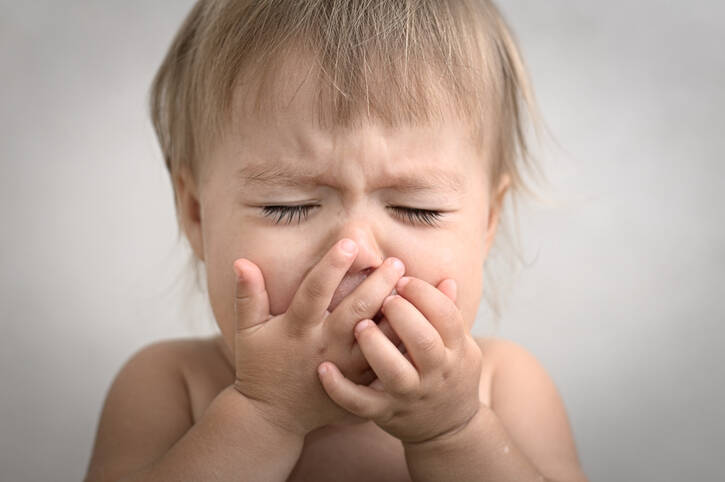- pediatriepropraxi.cz - Vomiting child
- wikiskripta.eu - Congenital hypertrophic pyloric stenosis
- pediatriapreprax.sk - Dehydration - a life-threatening condition in children
- solen.sk - Drinking regime in children
What are the dangers of vomiting in children? Risks of recurrent condition

Vomiting is quite common in children. This symptom entails a fairly wide range of different causes of its occurrence. Let's zoom in on situations when every parent should be alert.
Article content
- Appearance of vomit
- Vomiting and vomiting in infants
- Infections of the digestive system
- Vomiting in dietary error
- Vomiting in pylorostenosis
- Intestinal invagination
- Vomiting after head injury
- Other causes of vomiting
- Vomiting and dehydration
- How to prevent dehydration when vomiting
- What are the symptoms of dehydration?
- Why is dehydration especially dangerous in children?
Vomitus (vomiting) is usually a harmless symptom, but it can also be a life-threatening condition. It is therefore important to clarify the cause of vomiting in order to initiate appropriate treatment and necessary measures.
Vomiting especially threatens young children with the development of dehydration.
Vomiting is a defensive reflex that causes the stomach to empty through the oral cavity. This is how the body defends itself from the influence of certain toxins.
In addition to vomiting, which is unpleasant enough on its own, there is usually also the so-called nausea. This is an unpleasant feeling and urge to vomit. Its presence or absence can also be helpful in the search for the cause of vomiting.
Basically, we distinguish between vomiting that originates in the digestive system and vomiting of other origins.
So-called prolonged vomiting should not be ignored.
This refers to vomiting that persists:
- more than 12 hours in a newborn
- more than 24 hours in children under two years of age
- more than 48 hours in older children
Appearance of vomit
The content of vomit naturally depends on the food or liquids ingested.
The vomit is usually yellowish in colour. This is due to the small amount of bile that enters the stomach during vomiting. This is quite common.
However, it is necessary to be alert if the vomit is greenish. This is when a larger amount of bile is present. This may indicate gallbladder problems, but also intestinal obstruction.
Another warning sign is the presence of blood or an admixture resembling coffee grounds.
In both cases, it is bleeding in the digestive system, which requires seeking medical attention.
Vomiting and vomiting in infants
In newborns and infants, harmless vomiting is often encountered. However, this is not vomiting in the true sense of the word.
This is caused by an immature closure of the lower oesophageal sphincter. Milk easily passes from the stomach into the oesophagus and the baby burps.
It occurs especially with increased flatulence of the intestines and stomach, increased physical activity of the baby after feeding or during overfeeding.
We can also talk about so-called regurgitation.
In a child who is thriving normally, this is not a serious problem. Although he may often be nervous and weepy from the irritation of the oesophagus by gastric juices, the condition usually corrects itself during the first year of life.
Such vomiting does not need to be treated.
However, if you feel that the vomiting is too frequent, voluminous, or arch vomiting is present, contact your doctor.
You may also be interested in the article.
Infections of the digestive system
The most common causes of vomiting in children are infections of the gastrointestinal system. That is, the system of the stomach and intestines.
However, vomiting often occurs also with any inflammation of another system. An example may be otitis media, pneumonia, kidney.
Especially in children of infancy, vomiting is the first sign of any infection.
Diarrhoea, abdominal pain and vomiting are typical symptoms. More familiar is the name intestinal virosis.
Read also the article on gastritis (inflammation of the stomach)
Vomiting in dietary error
Dietary error is a large group of reasons for vomiting.
This arises after eating not very fresh food, fatty or sweet foods, or an inappropriate combination of these.
Have you come across the term postprandial vomiting and don't know what it means?
It means vomiting occurring after eating.
You can also find interesting information in the article: What is the right diet for diarrhea, constipation or vomiting?
Vomiting in pylorostenosis
Vomiting in a stream that escalates is typical of a disease called pylorostenosis. It affects infants between about 3 and 6 weeks of age.
The pylorus is the last, lower part of the stomach that closes or opens as needed. This is how food travels from the stomach to the duodenum - the small intestine.
In pylorostenosis, the pylorus thickens and closes. Often a so-called peristaltic wave or palpable resistance - a lump the size of a hazelnut - is seen on the baby's tummy.
Although the child has a good appetite, this disorder quickly makes the child apathetic, dehydrated and, of course, not thriving. Unlike vomiting caused by a viral gastrointestinal illness, stool output is minimal.
Even how the vomiting itself proceeds can give us clues as to its cause.
Intestinal invagination
Another possible cause of vomiting can be a condition called intestinal invagination. This is the insertion of the intestine into the next part of the intestine.
The typical symptom for this disorder is significant abdominal pain. It occurs at intervals that may become shorter. Vomiting is present, but neither stools nor winds pass.
Dehydration of the body occurs easily. The condition requires surgical management.
Conditions associated with obstruction (impaired patency) of the bowel are accompanied by severe pain, vomiting and the appearance of large amounts of bile in the vomit. All these conditions require surgical management as soon as possible.
Read also the article about intestinal obstruction.
Vomiting after head injury
Vomiting can also occur after a head injury.
It can be one of the symptoms of a concussion. If your child has had an accident and develops symptoms such as vomiting, drowsiness confusion or memory impairment, be sure to seek professional help.
According to some sources, a concussion can occur even after an accident in which there was no direct blow or head injury.
Symptoms of a concussion may appear even hours after the injury.
Read more in the article.
Other causes of vomiting
Other possible causes of vomiting include diabetes mellitus, metabolic disorders, intoxication, bulimia and, in older age, pregnancy.
Treatment of vomiting is directed at the calling cause.
The most common causes of vomiting
| Viral diseases | diseases of the digestive system, systemic inflammatory diseases |
| fever | febrile conditions |
| dietary error | inappropriate choice or combination of foods |
| poisoning | poisoning by food, alcohol, berries, etc. |
| pylorostenosis | malfunction of the pylorus |
| intestinal invagination | insertion of the intestinal clamp into the thicker part of the intestine |
| concussion | after a head injury |
| diabetes mellitus | impaired insulin secretion or action |
| bulimia, anorexia | eating disorder |
| pregnancy | one of the first manifestations of pregnancy |
| migraine | seizure headaches |
| ileus | intestinal obstruction, impaired passage of intestinal contents |
Vomiting and dehydration
Dehydration is a risk that can occur with any recurrent vomiting. It occurs especially in febrile states or diarrhoea.
Read also the articles:
What are the most common symptoms of dehydration
Dehydration in children can be dangerous
How to prevent dehydration when vomiting
Preventing dehydration from occurring is important in any situation.
If a child vomits, has a fever or diarrhea, trying to prevent dehydration can be more complicated.
Therefore, if there are signs of dehydration or any doubts, do not hesitate to seek medical attention.
For babies who are breastfed, consult a doctor about giving fluids. However, never give anything other than boiled water. Breastfeed the baby more often.
For non-breastfed children, do not give milk for 8 to 12 hours. Offer tea or rice decoction in small amounts.
However, start with only one to two teaspoons. If the baby does not vomit and retains this small amount of liquid, slowly increase the volume.
You can start giving milk in small amounts if the baby has not vomited for 8 hours.
It is also possible to buy a rehydration solution at the pharmacy to replenish fluids, but also lost electrolytes and minerals.
Inappropriate drinks when vomiting are milk, juices and sweet drinks.
Children and adults lose water not only through urination, but also through breathing, stool, sweating and tears.
What are the symptoms of dehydration?
In infants, you may notice a slightly sunken fontanelle in addition to dry diapers.
The fontanelle is the ligamentous connection between the bones of the skull in a newborn. The so-called greater fontanelle is located between the frontal bone and the two temporal bones.
Other symptoms include:
- the baby does not wet for 6 to 8 hours
- dry mouth, lips and tongue
- reduced skin tension
- rapid breathing and pulse
- weakness
- malaise
- apathy of the child
- disorientation
- disturbance of consciousness
Feeling thirsty is considered a delayed symptom.
Fluids should be taken by children and adults so that thirst does not occur at all.
Why is dehydration especially dangerous in children?
Children are more prone to dehydration. This is mainly due to their fast metabolism as well as their smaller compensatory mechanisms.
You may also be interested in this article:
A childis not a miniature of an adult! What are the differences?
Lack of water in the body can cause kidney damage. Water helps to dissolve calcium, reducing the risk of kidney stones.
Water also acts to cool the body. By sweating, the body maintains proper thermoregulation. This protects it from overheating.
When dehydrated, fatigue and malaise occur. Sweating also eliminates minerals from the body, which also contributes to body weakness.
Muscle cramps, disturbances of consciousness and, in severe conditions, death are also imminent.
Interesting resources










